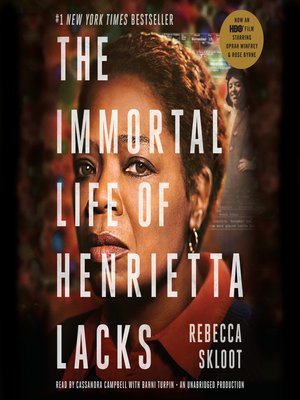
She began visiting the hospital for tests, but initially told no one about her cancer. Particularly groundbreaking was the invention of the polio vaccine in 1954, which subsequently saved millions of lives. After an exam, a cancerous tumor was found on her cervix. The Immortal Life of Henrietta Lacks, 6.24 Buy It Now, Click to see shipping cost, eBay Money Back Guarantee Seller: (76,635) 99. Historical Context of The Immortal Life of Henrietta Lacks Almost every medical innovation of the past half century has been directly related to the cells of Henrietta Lacks.
THE IMMORTAL LIFE OF HENRIETTA LACKS SPARK NOTES PDF
in the midst of them is this The Immortal Life Of Henrietta Lacks Rebecca Skloot Pdf that can be your partner. Her local doctor sent her to Johns Hopkins Hospital to see a gynecologist. We present The Immortal Life Of Henrietta Lacks Rebecca Skloot Pdf and numerous books collections from ctions to scientic research in any way. It also tells the story of her legacy: the. When she was twenty-nine, shortly after Joe’s birth, Henrietta noticed unusual bleeding and a lump in her lower abdomen. It tells the story of an African-American woman who died in 1951, aged just 31, of an aggressive cervical cancer. Henrietta was beautiful, fun-loving, and beloved by her family and friends. After moving to Turner Station, Day and Henrietta had three more children, David Sonny Lacks, Deborah Lacks, and Joe Lacks. They would eventually send her to a state mental institution. Their first daughter, Elsie, was mentally challenged and suffered from epilepsy. Henrietta gave birth to Lawrence just after she turned fourteen. Henrietta and Day eventually moved to Turner Station so Day could get a more lucrative job at the steel mill, and together they had five children. One of these cousins was David Day Lacks, who would become her husband. Henrietta grew up in Clover, Virginia, where she lived and worked on a tobacco farm with her grandfather, Tommy Lacks, and many cousins. Meanwhile, Henrietta underwent treatment for her cervical cancer but succumbed to the disease, leaving behind her five children and husband.

When the family learned the truth, they endured turmoil and heartache in the decades that followed. At the time, no human cells had ever survived long in a laboratory, but Henrietta’s cancer cells, which Gey labeled as HeLa, survived.

Her family, however, did not know until much later that researchers were using Henrietta’s cells in their experiments. It also raises questions about ethics, consent and profit in medicine.Rebecca Skloot’s book, The Immortal Life of Henrietta Lacks, chronicles the life, death, and immortality of Henrietta Lacks, a young black woman whose cervical cancer cells became one of the most important factors in bringing about important scientific and medical advancements in the twentieth century. It has been used in a vast and varied array of scientific research including research into cancer, the human genome, and the development of the polio vaccine, and it continues to be used to this day. It also tells the story of her legacy: the HeLa cell line, taken from Henrietta’s tumor while she was still alive, cultured in a lab, and discovered to be immortal.Īfter her death HeLa was mass-produced and sold to laboratories all over the world. The Immortal Life of Henrietta Lacks tells the story of an African American woman who died in 1951, aged just 31, of an aggressive cervical cancer. Snacks and drinks will be provided to those who register in advance. The Immortal Life of Henrietta Lacks features explanations of key themes, motifs and symbols, including: humanity immortality and legacy scientific racism. Please join the Office of Diversity, Equity and Inclusion and the Women in NEOMED ERG for a Women's History Month Celebration showing of The Immortal Life of Henrietta Lacks on Wednesday, March 29 from 12:15 p.m.


 0 kommentar(er)
0 kommentar(er)
